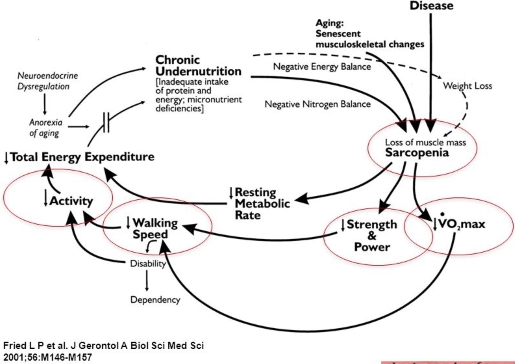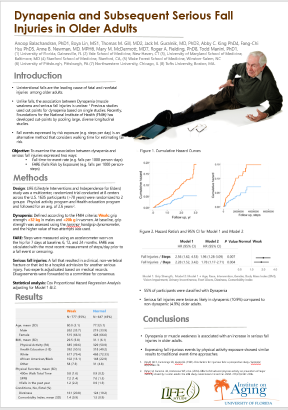International Frailty and Sarcopenia Conference 2018 Review
April 01 2018
Here is my review of the sarcopenia conference held in Miami Beach on March 1-3, 2018.

As the name suggests, the conference is aimed at understanding age-related muscle loss and frailty. This my first time attending this conference, and compared to other conferences, the scope is quite narrow and only attracts a small crowd of 500-700 attendees. The conference seems to go all over the globe and has a lot of international attendees. Last year it was held in Barcelona, Spain. So off goes me and my mentor to the sunny Miami Beach.
This was a 3-day conference so there were quite a few presentations. Below are the some of the presentations I attended and thought were noteworthy to write about.
Frailty
The key note speaker was Linda Dr. Linda Fried, the Dean of Columbia’s University’s (NY) Public health department. In fact, she was also honored with Lifetime achievement award at the conference. And her work was instrumental in defining frailty and bringing frailty to the forefront of clinical research. Her keynote lecture was on what has been done on frailty and what needs to be done
Frailty is condition that is barely known to many; at least I wasn’t until I stated my post doctorate. Frailty is defined as a distinct condition/phenotype that is indicated by the presence of 3 out of 5 conditions: muscle weakness, slow gait, low physical activity, low energy or exhaustion, and unintentional weight loss. It is not a disease or a group of disease or disability as some of us might think. If you can think about anyone who is old, thin, slow, weak, and sedentary, then you have come across frailty. Almost 7% of people in US are frail and we don’t really know what causes frailty. Below is the cycle of frailty from her paper.

And which is the best way to prevent frailty? I will give you one guess.
Muscle Stem Cells & Aging
Next talk was by Charlotte A. Peterson at University of Kentucky, Lexington about role of satellite cells in sarcopenia. Her research showed that the lack of satellite cells or their activity was not a contributing factor in sarcopenia. One of the prevailing hypothesis is that the lack of satellite cells/stem cells could contribute in older adults.
However, I have to say her experiments were in a mice model and goes counter to some of the recent human pilot showing favorable effects on function with stem cells infusion. In fact, a phase 2 study funded by NIH is currently looking at the efficacy and safety of stem cell infusion in humans to improve function. Just like many people would say, conclusions from animal studies should stay within the realm of animal studies and only serve as a hypothesis for human studies.
ENRGIZE Pilot Trial
Next in line was the enrgize trail: Dr. Marc Pahor (Director of Aging, Institute at University of Florida) talked about the design and rational of the study while Dr. Manini (my mentor) introduced some of the baseline association in the study.
The Enrgize is a 10 million, multi-center, double-blind, 1-year pilot trial which randomized 300 older adults with high inflammation and low walk speed into 3 groups: fish oil, losaratan and a placebo group. (and yes you read it right “10 million-dollar pilot trial”).
The rationale for the study is that the decline in physical function in older adults has shown to be related to age-related inflammation ( IL6, TNf-alpha, CRP). So if we can lower this low-grade inflammation, we may prevent the decline in function in older adults. We are the coordinating center and it is just amazing to watch the rigor involved in this study, especially due to the multi-centered nature of the study.
The baseline results showed statistically significant association between leg extension strength and fish oil supplementation, but not for other measures of function. The study is in the final stages so we will know something soon.
SPRINTT Trial
The SRINTT trial is a large clinical trial spanning across 11 European countries looking to see if a multi-modal intervention (physical activity, nutrition) can prevent walking disability in older adults who are both pre-frail and sarcopenic.
Although there are few differences, the trial is very similar to the LIFE trial conducted in US and will serve as a replication of the LIFE study. The main difference between the LIFE are that in the SPRINTT are that in the SPRINTT the participants have low muscle mass measured using DXA and the intervention will include a nutritional component. I review the LIFE trial here:
The study finished recruiting and randomizing 1500 participants and the intervention is currently underway. The presentation showed some of the baseline characteristics of the participants and screening rates at different centers.
Capillarization & Muscle Growth
The was one interesting talk to say the least. Capillarization means the increase in blood vessels in the muscle. The increase in capillarization is usually considered to be an endurance training adaptation, and aging somehow tend to decrease capillarization.
In one of their resistance training studies in older adults, type 2 muscle fiber hypertrophy was observed only in the subgroup who had high capilliration, whereas no increase was observed in the low capillarization group. Further, they also showed greater satellite cell activity and proliferations in muscle fibers with higher capillarization.
Does the relationship hold true in younger folks? So endurance training good for increasing muscle?
D3-Cr
Deuterated Creatine (D3Cr) is a novel, emerging method to measure total body muscle mass. The method involved estimating muscle mass from creatine levels from fasted urine, after consuming a deuterated creatine capsule. Notably, unlike DXA to measure muscle, D3r can distinguish actual muscle tissue from hydration levels, connective tissue and intramuscular fat.
Dr. Peggy Cawthon showed some preliminary results showing the superiority of the method compared to DEXA for some measures. In fact, the pilot grant (100K) I received recently is based on this novel method. If the method turns out be as promising as the preliminary results, it will definitely change the way we measure muscle mass in the future.
Dynapenia & Serious Fall Injuries

My poster (shown here) was on the association between dynapenia (loss of strength) and serious fall injuries. We know strength loss to be a major risk factor for falls, but the role of strength on fall injuries is less clear. We also used the new grip strength guidelines developed by FNIH to diagnose weakness. Although it is been known for years that strength loss is a risk factor for falls, we are still struggling to settle on a cut-off point to diagnose muscle weakness and make treatment recommendations. And from what I understand talking to my mentor, the new classification doesn’t look that promising either.
Overall, the conference was very well organized and gave a glimpse of where the research on sarcopenia and frailty is currently at and heading towards. I wish they could have had a dedicated time for poster sessions. Unlike other conferences I have attended, there was no allotted time for posters so there was no one around the poster to interact/ ask questions. I always looking forward to the posters session for this reason, so was little disappointed to see all the orphaned posters. Another thing I noticed was that quite a few drug company representatives and companies were present at the conference. And I couldn’t help get the feeling that we will soon see a few drugs for treating sarcopenia in the next few years.
Anyway, that’s all I have for the sarcopenia conference. The conference is very expensive ($800 for non-students; $500 for students) so I am not sure I will be able to make it next year. But if you work/interested in the area of aging and physical function, this is the conference to attend and meet some big names.
Related Articles
| Wed April 11, 2018
Hey Anoop,
I was curious if there was anything at this conference, or if you’re aware of any work, regarding protein consumption?
We know protein intake is important when it comes to muscle maintenance in e.g. cutting bodybuilders. We also know the intake for optimal benefit tends to be much more than your average person is consuming or recommended.
One debate I remember, that still comes back here and there, is too much protein in a day, or too much protein at a time, could be detrimental. Last I checked, that’s been largely unfounded.
I was curious though, with a geriatric population, we’re basically guaranteed we’re talking more than one health issue going on at a time. Where if sarcopenia is happening, decreased e.g. kidney function is also happening. The fun of aging.
Where I wonder if there is any legitimate concern with this population in higher protein intakes? (Been meaning to start looking for research myself, but since you just went to this conference I figured I’d ask you first.)
Anoop | Thu April 12, 2018
Hey Brian,
Thanks for the comment. I saw quite a few studies on protein consumption, but none on the side effects or anything. In fact, the SPRINTT trial I wrote about includes protein consumption.
I think if you have kidney disease, protein diets might be a concern. And I don’t see a 25-30% increase from the RDA tbe a major increase in protein.
There was a recent rial in JAMA (well-controlled) which looked at high protein diets in older adults without exercise for 6 months. No difference although experts have said its gonna make a world of difference. I had posted this on the facebook page. I haven’t see any long-term studies in older adults if exercise and high-protein consumption could make a difference.
Also, you might be interested in some of the pain articles I wrote.
| Wed April 18, 2018
Thank you for the response!
>










